On the 17th Dec 2022 member George Buckberry captured this super image of Sirius, Orion, Hyades in Taurus with Mars above and the Pleiades. The photo was taken on a mobile Samsung SE20 in night mode and tweaked in Snapseed by George.
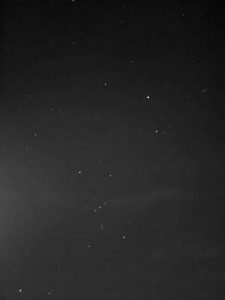
Astronomy every Thursday
This category will show a few lines from the last 3 items on the home page.
It will also show the full post on the news page
On the 17th Dec 2022 member George Buckberry captured this super image of Sirius, Orion, Hyades in Taurus with Mars above and the Pleiades. The photo was taken on a mobile Samsung SE20 in night mode and tweaked in Snapseed by George.

It was a very busy night for CMHASD meteor camera on the 14th/15th Dec 2022. The Meteor camera captured 141 'sightings' of which 126 were meteors including 4 sightings of 2 meteors in the same shot by the camera. Out of the 126 meteors 98 were Geminids; the rest were other classes of meteors including some sporadics.
Meteors, also known as shooting stars, are pieces of dust and debris from space that burn up in Earth's atmosphere, where they can create streaks across the night sky. When Earth passes through the dusty trail of a comet or asteroid's orbit, the many streaks of light in the sky are known as a meteor shower. The 98 Geminid meteors detected by the camera were part of the annual Geminid meteor shower.
For more information about the society meteor camera & project click here.
For more information about the Geminid Meteor Shower please visit the UKMON website at https://ukmeteornetwork.co.uk/showers/2022-geminids/
Below are two out of the 4 photos showing the double meteors captured by the camera.
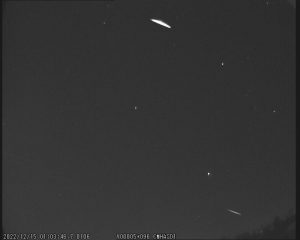
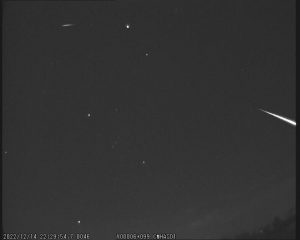
NEVER LOOK AT THE SUN DIRECTLY. Please see our Solar Observing safety page at crayfordmanorastro.com/solar-safety/
On the morning of Sunday 15th January 2023, CMHASD member Honor Wheeler captured this absolutely stunning image of the Sun. As you can see it was very active and still is! Details of how Honor acquired her brilliant image are on the photo.
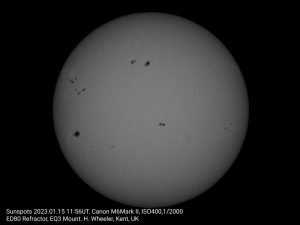
The information below is taken from the website Spaceweather.com
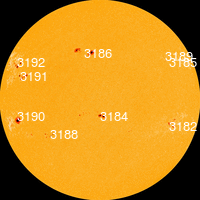
Picture above shows the Sun on 15th January 2023 - taken by the Solar Dynamics Observatory with the Sun spots labelled.
'''...I can't remember having seen so many sunspots together; indeed, the sunspot number is high. If solar activity continues at this pace for the rest of January, the monthly sunspot number will reach a 20-year high. And Solar Maximum is still ~2 years away. Contrary to predictions, Cycle 25 is shaping up to be a good one, after all.''
17th Jan 2023
''NAKED-EYE SUNSPOT: One of the biggest sunspots in years (AR3190) is crossing the solar disk--and you can see it with the naked eye. "Be sure to use safe solar glasses to protect your eyes," says Bum-Suk Yeom of Iksan, South Korea. "I tried it myself today, and I could see the sunspot clearly."
As shown in Yeom's infographic, the sunspot is four times wider than Earth. It's twice as big as any other spot on the sun, visible to the naked eye, and a magnificent target for backyard solar telescopes.
Best of all, it's about to explode. AR3190 has an unstable 'beta-gamma-delta' magnetic field that harbors energy for X-class solar flares. Any eruptuions will be geoeffective because the sunspot is almost directly facing Earth.'' ''
It was a brilliant quiz and a great night was had by all! Member's David Grist and Steve Floodgate aka Eric 'n' Ern once again pulled out all the stops to provide another night of head scratching, puzzlement and fun.
Below are some photos and a video of the evening taken by Chairman John Archer. Thank you John.
Plus a big ‘Thank you’ to Dave & Steve for all your hard work & effort creating the quiz. We are all looking forward to the next one!
[ngg src="galleries" ids="71" display="basic_slideshow"][playlist type="video" ids="7415"]
CMHASD member Jim Burchell captured this superb Sun Halo on the 14th Dec 2022 around midday which lasted for quite a long time - over an hour. A Sun halo, also known as '22 degree halo', is an optical atmospheric phenomenon that occurs due to sunlight refracting in millions of hexagonal ice crystals suspended in the atmosphere.
More information about how Sun Halo's are formed can be found on the Atmospheric Optics website.
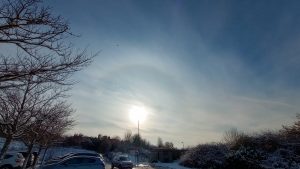
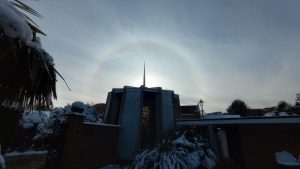
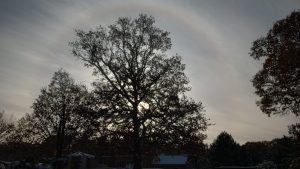
Nine CMHASD members attended the BAA Christmas meeting on the 10th December 2022, held at the Institute of Physics.
A recording of the meeting is available to watch here on the BAA YouTube channel.
Below are the times of the talks in the recording. Please be aware the sound is a little quiet at times so you will need to turn up the sound up. Talks particular of interest to our Society are in bold; as they have CMHASD member 'participation' :-)
Start – David Arditti, BAA President – Welcome, notices and awards - Here you will see CMHASD trustees Martin Crow and Simon Dawes collect their BAA Sir Patrick Moore award for their contributions to the ExoClock Project.

0h 27m – Tim Parsons – A Massive Star Menagerie: touring through the upper reaches of the H-R Diagram
1h 25m – Simon Kidd – Asteroid Occultations….an observer’s view
2h 8m – Nick James – Sky Notes - Here you will see CMHASD member Honor Wheeler's Moon image displayed during Nick's talk and a photo of a model of Jupiter that was used at the News Scientist Live exhibition 2022. CMHASD member Janice McClean, who is the BAA Events Manager and several other CMHASD members helped run the BAA stand at the exhibition over the 3 days.

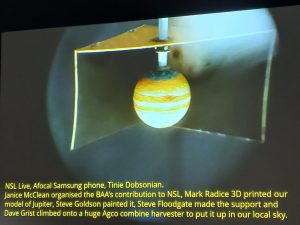
After the meeting for those who wished to partake - members were invited the BAA Christmas social, taking place in the Hubble Room at The Astronomer pub near Liverpool Street Station. Several CMHASD members took up the invite :-D I wonder who was one of the members?
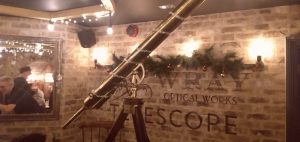
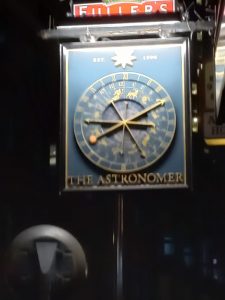
Below are more photos of the day taken by CMHASD Chairperson John Archer & CMHASD Trustee John Howarth. Thank you for sharing your photos with us.
[ngg src="galleries" ids="70" display="basic_slideshow"]
On Wednesday 30th November 2022, CMHASD were back at Hall Place & Gardens to hold a star gazing event. We had brilliant support from our members – thanks to all – who bought along a variety of telescopes, cameras, meteorites and other displays for our guests.
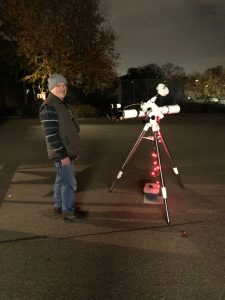
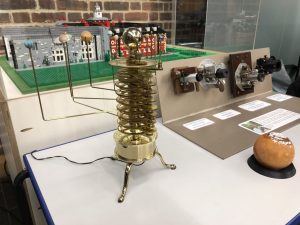
We had over 33 ticket-holders to entertain and those who arrived early did catch sight of Jupiter, Mars and the Moon.
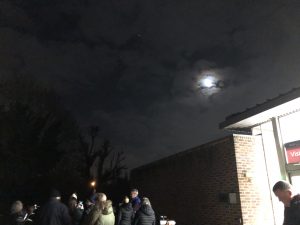
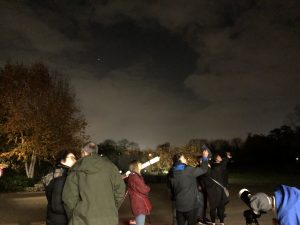
We ran through a handful of short talks – including a review of popular astronomy apps by Marc and a talk from Debra on Comets, followed by a successful comet-making demo to an enthralled audience.
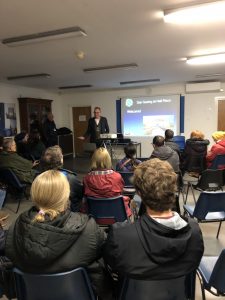
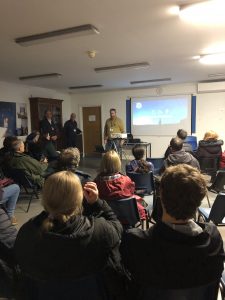
Further gaps in the clouds allowed visitors another chance to observe with us. It’s always rewarding to hear the “oohs and aahs” of a first-time view of Jupiter’s moons through a decent scope. The Society Dob’s are just brilliant at that.
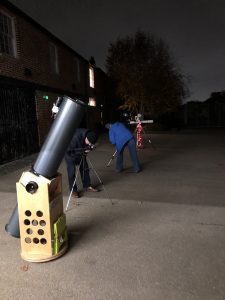

So thank you to the whole crew (you know who you are) for setting up, interacting, educating and closing down the show. It was very successful indeed.
[ngg src="galleries" ids="69" display="basic_slideshow"]
A huge congratulations to CMHASD trustees Martin Crow and Simon Dawes for jointly winning the BAA Sir Patrick Moore Prize for Pro-Am work on Exoplanet observations with the ExoClock project along with a Mr Adrian Jones.
Below is a photo of Martin and Simon being presented with their certificates by the President of the BAA David Arditti on Saturday 10th December 2022 at the BAA Christmas Meeting.
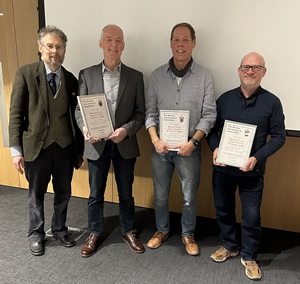
From left to right: David Arditti, Adrian Jones, Martin Crow & Simon Dawes.
It is our 61st Anniversary today and what a lovely way to mark the occasion - to sit back, relax and enjoy this superb video slide show of the society through the years created by long standing member Arthur Cockburn.......
The videos from the British Astronomical Association (BAA) Exoplanet Division Online Workshop held on Saturday 12th November are now available to watch on the BAA YouTube Channel.
The below talk titles are links to watch the videos.
Two videos are by CMHASD members Rodney Buckland and Martin Crow.
Exoplanet Division update
EXPLORE introduction
Ariel and ExoClock with Anastasia Kokori
Mission and observational efficiency
ExoClock – a model of pro-am collaboration
EXPLORE Part 1 – Detecting exoplanets with Rodney Buckland
Observation
Modelling
Searching databases
Zooniverse
How to discover an exoplanet (telescope and camera not required) with Roger Dymock
EXPLORE Part 2 with Martin Crow
Introduction to HOPS
Synchronous observations to detect shallow transits
Data mining transit observations for variable star photometry
An alternative to HOPS
Observing with robotic telescopes by Rodney Buckland
EXPLORE NEEDS EXPLORERS with Roger Dymock
Rodney's Video
Martin's Video